Towards a Predictive Simulation of Turbulent Combustion?—An Assessment for Large Internal Combustion Engines
Abstract
:1. Introduction
2. Basic Challenges of Turbulent In-Cylinder Flow
3. Boundary Conditions
3.1. Wall Flow and Heat Transfer
3.2. Gas Exchange and Cylinder Pressure
3.3. Injection and Spark Ignition
4. Mixture Preparation and Ignition
5. Combustion
5.1. Flame Propagation
5.2. Irregular Combustion
6. Emissions
6.1. Hydrocarbons
6.2. Nitric Oxides
6.3. Soot and Particles
7. Conclusions
Author Contributions
Funding
Acknowledgments
Conflicts of Interest
References
- Lauer, T. Towards Prediction of Turbulent Combustion and Pollutant Formation?–Current Modelling Approaches with a Focus on Large Engines. In Proceedings of the 17th Conference the Working Process of the Internal Combustion Engine, Graz, Austria, 26 September 2019. [Google Scholar]
- CO2 Emission Performance Standards for Cars and Vans (2020 Onwards). Available online: https://ec.europa.eu/clima/policies/transport/vehicles/regulation_en (accessed on 17 October 2020).
- Towards a Climate-Neutral Germany–Three Steps for Achieving Climate Neutrality by 2050 and an Intermediate Target of −65% in 2030 as Part of the EU Green Deal. Available online: https://www.agora-energiewende.de/en/publications/towards-a-climate-neutral-germany-executive-summary/ (accessed on 4 October 2020).
- Pope, S.B. Turbulent Flows; Cambridge University Press: Cambridge, UK, 2011. [Google Scholar]
- Ferziger, J.H.; Perić, M. Computational Methods for Fluid Dynamics; Springer: Berlin/Heidelberg, Germany, 2002. [Google Scholar]
- Schmitt, M.; Frouzakis, C.E.; Tomboulides, A.G.; Wright, Y.M.; Boulouchos, K. Direct numerical simulation of the effect of compression on the flow, temperature and composition under engine-like conditions. Proc. Combust. Inst. 2015, 35, 3069–3077. [Google Scholar] [CrossRef]
- Schmitt, M.; Frouzakis, C.E.; Wright, Y.M.; Tomboulides, A.; Boulouchos, K. Direct numerical simulation of the compression stroke under engine relevant conditions: Local wall heat flux distribution. Int. J. Heat Mass Transf. 2016, 92, 718–731. [Google Scholar] [CrossRef]
- Benekos, S.; Frouzakis, C.E.; Giannakopoulos, G.K.; Bolla, M.; Wright, Y.M.; Boulouchos, K. Prechamber ignition: An exploratory 2-D DNS study of the effects of initial temperature and main chamber composition. Combust. Flame 2020, 215, 10–27. [Google Scholar] [CrossRef]
- Shepherd, I.; Moss, J.; Bray, K. Turbulent transport in a confined premixed flame. Symp. Int. Combust. 1982, 19, 423–431. [Google Scholar] [CrossRef]
- Oefelein, J.C. Large eddy simulation of turbulent combustion processes in propulsion and power systems. Prog. Aerosp. Sci. 2006, 42, 2–37. [Google Scholar] [CrossRef]
- Rutland, C. Large-eddy simulations for internal combustion engines—A review. Int. J. Engine Res. 2011, 12, 421–451. [Google Scholar] [CrossRef] [Green Version]
- Hasse, C. Scale-resolving simulations in engine combustion process design based on a systematic approach for model development. Int. J. Engine Res. 2015, 17, 44–62. [Google Scholar] [CrossRef] [Green Version]
- Merker, G.P.; Schwarz, C.; Teichmann, R. (Eds.) Simulation of Combustion and Charging. In Combustion Engines Development: Mixture Preparation, Combustion, Emissions and Simulation; Springer: Berlin/Heidelberg, Germany, 2011. [Google Scholar]
- Ilie, M. Numerical studies of turbulent swirling reacting flows using LES and URANS. Int. J. Therm. Sci. 2018, 134, 89–100. [Google Scholar] [CrossRef]
- Zöchbauer, M.; Smith, H.; Lauer, T. Advanced SCR Flow Modeling with a Validated Large Eddy Simulation; SAE Technical Paper Series; SAE Technical Paper 2015-01-1046; SAE International: Warrendale, PA, USA, 2015. [Google Scholar]
- Nemati, A.; Ong, J.C.; Jensen, M.V.; Pang, K.M.; Mayer, S.; Walther, J.H. Numerical Study of the Scavenging Process in a Large Two-Stroke Marine Engine Using URANS and LES Turbulence Models; SAE Technical Paper Series; SAE Technical Paper 2020-01-2012; SAE International: Warrendale, PA, USA, 2020. [Google Scholar]
- Hemmingsen, C.S.; Ingvorsen, K.M.; Mayer, S.; Walther, J.H. LES And URANS simulations of the swirling flow in a dynamic model of a uniflow-scavenged cylinder. Int. J. Heat Fluid Flow 2016, 62, 213–223. [Google Scholar] [CrossRef]
- Yang, X.; Gupta, S.; Kuo, T.-W.; Gopalakrishnan, V. RANS and Large Eddy Simulation of Internal Combustion Engine Flows—A Comparative Study. J. Eng. Gas Turbines Power 2014, 136, 051507. [Google Scholar] [CrossRef]
- Liu, K.; Haworth, D. Large-Eddy Simulation for an Axisymmetric Piston-Cylinder Assembly with and Without Swirl. Flow Turbul. Combust. 2010, 85, 279–307. [Google Scholar] [CrossRef]
- Baum, E.L.; Peterson, B.; Surmann, C.; Michaelis, D.; Böhm, B.; Dreizler, A. Investigation of the 3D flow field in an IC engine using tomographic PIV. Proc. Combust. Inst. 2013, 34, 2903–2910. [Google Scholar] [CrossRef]
- Schiffmann, P.; Gupta, S.; Reuss, D.L.; Sick, V.; Yang, X.; Kuo, T.-W. TCC-III Engine Benchmark for Large-Eddy Simulation of IC Engine Flows. Oil Gas Sci. Technol. Rev. 2015, 71, 3. [Google Scholar] [CrossRef] [Green Version]
- Reuss, D.L.; Zhong, Z.; Yang, X.; Kuo, T.-W.; Sick, V. Measured and LES Motored-Flow Kinetic Energy Evolution in the TCC-III Engine; SAE Technical Paper Series; SAE International: Warrendale, PA, USA, 2018. [Google Scholar] [CrossRef]
- Ko, I.; Rulli, F.; Fontanesi, S.; D’Adamo, A.; Min, K. Methodology for the large-eddy simulation and particle image velocimetry analysis of large-scale flow structures on TCC-III engine under motored condition. Int. J. Engine Res. 2020. [Google Scholar] [CrossRef]
- Krastev, V.K.; D’Adamo, A.; Berni, F.; Fontanesi, S. Validation of a zonal hybrid URANS/LES turbulence modeling method for multi-cycle engine flow simulation. Int. J. Engine Res. 2019, 21, 632–648. [Google Scholar] [CrossRef]
- Goryntsev, D.; Sadiki, A.; Klein, M.; Janicka, J. Large eddy simulation based analysis of the effects of cycle-to-cycle variations on air–fuel mixing in realistic DISI IC-engines. Proc. Combust. Inst. 2009, 32, 2759–2766. [Google Scholar] [CrossRef]
- Postrioti, L.; Paltrinieri, S.; Tiberi, A.; D’Adamo, A. LES Multi-Cycle Analysis of a High Performance GDI Engine; SAE Technical Paper Series; SAE International: Warrendale, PA, USA, 2013. [Google Scholar] [CrossRef]
- Brußies, E. Simulation der Zylinderinnenströmung eines Zweiventil-Dieselmotors mit Einem Skalenauflösenden Turbulenzmodell. Ph.D. Thesis, TU Darmstadt, Darmstadt, Germany, 2013. [Google Scholar]
- Angelberger, C.; Poinsot, T.; Delhay, B. Improving Near-Wall Combustion and Wall Heat Transfer Modeling in SI Engine Computations; SAE Technical Paper Series; SAE International: Warrendale, PA, USA, 1997. [Google Scholar] [CrossRef]
- Keum, S.; Park, H.; Babajimopoulos, A.; Assanis, D.N.; Jung, D. Modelling of heat transfer in internal combustion engines with variable density effect. Int. J. Engine Res. 2011, 12, 513–526. [Google Scholar] [CrossRef]
- Berni, F.; Cicalese, G.; Fontanesi, S. A modified thermal wall function for the estimation of gas-to-wall heat fluxes in CFD in-cylinder simulations of high performance spark-ignition engines. Appl. Therm. Eng. 2017, 115, 1045–1062. [Google Scholar] [CrossRef]
- Šarić, S.; Basara, B.; Suga, K.; Gomboc, S. Analytical Wall-Function Strategy for the Modelling of Turbulent Heat Transfer in the Automotive CFD Applications; SAE Technical Paper Series; SAE International: Warrendale, PA, USA, 2019. [Google Scholar] [CrossRef]
- Šarić, S.; Basara, B.; Gomboc, S.; Pavlović, Z. Towards Mesh Independent Modeling of Convective Heat Transfer in IC Engines; IMEM: Detroit, MI, USA, 2019. [Google Scholar]
- Mandanis, C.; Schmitt, M.; Koch, J.; Wright, Y.M.; Boulouchos, K. Wall Heat Flux and Thermal Stratification Investigations during the Compression Stroke of an engine-like Geometry: A comparison between LES and DNS. Flow Turbul. Combust. 2017, 100, 769–795. [Google Scholar] [CrossRef]
- Wu, A.; Keum, S.; Sick, V. Large Eddy Simulations with Conjugate Heat Transfer (CHT) modeling of Internal Combustion Engines (ICEs). Oil Gas Sci. Technol. Rev. 2019, 74, 51. [Google Scholar] [CrossRef] [Green Version]
- Cicalese, G.; Berni, F.; Fontanesi, S.; D’Adamo, A.; Andreoli, E. A Comprehensive CFD-CHT Methodology for the Characterization of a Diesel Engine: From the Heat Transfer Prediction to the Thermal Field Evaluation; SAE Technical Paper Series; SAE International: Warrendale, PA, USA, 2017; Volume 1. [Google Scholar] [CrossRef]
- Leguille, M.; Ravet, F.; Le Moine, J.; Pomraning, E.; Richards, K.; Senecal, P.K. Coupled Fluid-Solid Simulation for the Prediction of Gas-Exposed Surface Temperature Distribution in a SI Engine; SAE Technical Paper Series; SAE International: Warrendale, PA, USA, 2017; Volume 1. [Google Scholar] [CrossRef]
- Ameen, M.; Som, S. Capturing Cyclic Variability in SI Engines with High-Fidelity LES Using a New Parallel Perturbation Approach; IMEM: Detroit, MI, USA, 2017. [Google Scholar]
- Ameen, M.M.; Yang, X.; Kuo, T.-W.; Som, S. Parallel methodology to capture cyclic variability in motored engines. Int. J. Engine Res. 2016, 18, 366–377. [Google Scholar] [CrossRef]
- Probst, D.; Wijeyakulasuriya, S.; Pal, P.; Kolodziej, C.; Pomraning, E. Accelerating Computational Fluid Dynamics simulations of Engine Knock using a Concurrent Cycles Approach. In Proceedings of the ASME 2020 Internal Combustion Engine Fall Technical Conference, Denver, CO, USA, 4 November 2020. [Google Scholar]
- Jupudi, R.S.; Finney, C.E.; Primus, R.; Wijeyakulasuriya, S.; Klingbeil, A.E.; Tamma, B.; Stoyanov, M. Application of High Performance Computing for Simulating Cycle-to-Cycle Variation in Dual-Fuel Combustion Engines; SAE Technical Paper Series; SAE International: Warrendale, PA, USA, 2016; Volume 1. [Google Scholar] [CrossRef]
- Yue, Z.; Hessel, R.; Reitz, R.D. Investigation of real gas effects on combustion and emissions in internal combustion engines and implications for development of chemical kinetics mechanisms. Int. J. Engine Res. 2018, 19, 269–281. [Google Scholar] [CrossRef]
- Yue, Z.; Reitz, R.D. Numerical investigation of radiative heat transfer in internal combustion engines. Appl. Energy 2019, 235, 147–163. [Google Scholar] [CrossRef]
- Aronsson, U.; Solaka, H.; Lequien, G.; Andersson, Ö.; Johansson, B. Analysis of Errors in Heat Release Calculations Due to Distortion of the In-Cylinder Volume Trace from Mechanical Deformation in Optical Diesel Engines. SAE Int. J. Engines 2012, 5, 1561–1570. [Google Scholar] [CrossRef]
- Figer, G.; Schmidleitner, K.; Schönbacher, M.; Kammerdiener, T. 300 bar Peak Firing Pressure for a New Generation of Diesel and Gas Engines. MTZ Worldw. 2019, 80, 66–71. [Google Scholar] [CrossRef]
- Priesching, P.; Bogensperger, M.; Pavlović, Z.; Tatschl, R.; Vitek, O.; Božek, J. Tracking Cycle to Cycle Variations in a Gasoline DI Engine by Applying LES Combustion Modeling; IMEM: Detroit, MI, USA, 2012. [Google Scholar]
- D’Adamo, A.; Breda, S.; Fontanesi, S.; Cantore, G. LES Modelling of Spark-Ignition Cycle-to-Cycle Variability on a Highly Downsized DISI Engine. SAE Int. J. Engines 2015, 8, 2029–2041. [Google Scholar] [CrossRef]
- Goryntsev, D.; Sadiki, A.; Janicka, J. Investigation of Fuel-Air Mixing in DISI Engine using LES; SAE Technical Paper Series; SAE Technical Paper 2011-01-1886; SAE International: Warrendale, PA, USA, 2011. [Google Scholar]
- Reitz, R.D. Mechanism of atomization of a liquid jet. Phys. Fluids 1982, 25, 1730. [Google Scholar] [CrossRef]
- Stiesch, G. Modeling Engine Spray and Combustion Processes; Springer: Berlin/Heidelberg, Germany, 2003. [Google Scholar]
- Jiang, X.; Siamas, G.A.; Jagus, K.; Karayiannis, T.G. Physical modelling and advanced simulations of gas–liquid two-phase jet flows in atomization and sprays. Prog. Energy Combust. Sci. 2010, 36, 131–167. [Google Scholar] [CrossRef]
- Haworth, D.C. A Review of Turbulent Combustion Modeling for Multidimensional In-Cylinder CFD; SAE Technical Paper Series; SAE Technical Paper 2005-01-0993; SAE International: Warrendale, PA, USA, 2005. [Google Scholar]
- Steiner, R.; Bauer, C.; Krüger, C.; Otto, F.; Maas, U. 3D-Simulation of DI-Diesel Combustion Applying a Progress Variable Approach Accounting for Complex Chemistry; SAE Technical Paper Series; SAE Technical Paper 2004-01-0106; SAE International: Warrendale, PA, USA, 2004. [Google Scholar] [CrossRef]
- Pandal, A.; García-Oliver, J.; Pastor, J.M. Eulerian CFD modeling of nozzle geometry effects on ECN Sprays A and D: Assessment and analysis. Int. J. Engine Res. 2019, 21, 73–88. [Google Scholar] [CrossRef]
- Agarwal, A.; Trujillo, M.F. High Fidelity Simulations of Nozzle Internal Flow and its Effect on Breakup Behavior; IMEM: Detroit, MI, USA, 2019. [Google Scholar]
- Li, H.; Rutland, C. Uncertainty Quantification of Direct Injection Diesel and Gasoline Spray Simulations; SAE Technical Paper Series; SAE Technical Paper 2017-01-0836; SAE International: Warrendale, PA, USA, 2017; Volume 1. [Google Scholar] [CrossRef]
- Meyer, G.; Gschirr, A. Fundamental Aspects and Progress in Initial Flame Kernel Modeling for Modern Modulated Capacity Discharge High-Energy Ignition Systems. In Proceedings of the 15th Conference the Working Process of the Internal Combustion Engine, Graz, Austria, 24 September 2015. [Google Scholar]
- Schirru, A.; Irimescu, S.; Merola, A.; d’Adamo, S. Fontanesi, Flame Kernel Growth and Related Effects of Spark Plug Electrodes: Fluid Motion Interaction in an Optically Accessible DISI Engine. Int. J. Mech. Mechatron. Eng. 2020, 14, 95–103. [Google Scholar]
- Pei, Y.; Hawkes, E.R.; Kook, S.; Goldin, G.M.; Lu, T. Modelling n-dodecane spray and combustion with the transported probability density function method. Combust. Flame 2015, 162, 2006–2019. [Google Scholar] [CrossRef] [Green Version]
- Bolla, M.; Chishty, M.A.; Hawkes, E.R.; Kook, S. Modeling combustion under engine combustion network Spray A conditions with multiple injections using the transported probability density function method. Int. J. Engine Res. 2017, 18, 6–14. [Google Scholar] [CrossRef]
- Han, K.; Seo, J.; Huh, K.Y. Lagrangian conditionalmoment closure model with flame group interaction for lifted turbulent spray jet flames. Combust. Theory Model. 2017, 21, 419–439. [Google Scholar] [CrossRef]
- Borghesi, G.; Mastorakos, E.; Devaud, C.B.; Bilger, R.W. Modeling evaporation effects in conditional moment closure for spray autoignition. Combust. Theory Model. 2011, 15, 725–752. [Google Scholar] [CrossRef]
- De Paola, G.; Mastorakos, E.; Wright, Y.M.; Boulouchos, K. Diesel Engine Simulations with Multi-Dimensional Conditional Moment Closure. Combust. Sci. Technol. 2008, 180, 883–899. [Google Scholar] [CrossRef]
- Stanković, I. Modelling of non-premixed turbulent combustion with Conditional Moment Closure (CMC). Eur. Phys. J. E 2018, 41, 150. [Google Scholar] [CrossRef]
- Kahila, H.; Wehrfritz, A.; Kaario, O.; Masouleh, M.G.; Maes, N.; Somers, L.; Vuorinen, V. Large-eddy simulation on the influence of injection pressure in reacting Spray A. Combust. Flame 2018, 191, 142–159. [Google Scholar] [CrossRef]
- Andree, S.; Goryntsev, D.; Theile, M.; Henke, B.; Schleef, K.; Nocke, J.; Tap, F.; Buchholz, B.; Hassel, E. Numerical Simulation of a Large Bore Dual Fuel Marine Engine Using Tabulated Detailed Reaction Mechanisms; ASME: Chicago, IL, USA, 2019. [Google Scholar] [CrossRef]
- Seddik, O.; Pandurangi, S.; Bolla, M.; Boulouchos, K.; Srna, A.; Wright, Y.M. Flamelet Generated Manifolds Applied to Dual-Fuel Combustion of Lean Methane/Air Mixtures at Engine Relevant Conditions Ignited by n Dodecane Micro Pilot Sprays; SAE Technical Paper Series; SAE Technical Paper 2019-01-1163; SAE International: Warrendale, PA, USA, 2019. [Google Scholar] [CrossRef]
- Som, S.; Aggarwal, S. Effects of primary breakup modeling on spray and combustion characteristics of compression ignition engines. Combust. Flame 2010, 157, 1179–1193. [Google Scholar] [CrossRef]
- Li, H.; Rutland, C.; Im, H.; Perez, F.H. Large-Eddy Simulation of Turbulent Dispersion Effects in Direct Injection Diesel and Gasoline Sprays. SAE Int. J. Adv. Curr. Prac. Mobil. 2019, 1, 675–690. [Google Scholar] [CrossRef]
- Kundu, P.; Ameen, M.M.; Som, S. Importance of turbulence-chemistry interactions at low temperature engine conditions. Combust. Flame 2017, 183, 283–298. [Google Scholar] [CrossRef]
- Pucilowski, M.; Jangi, M.; Fatehi, H.; Pang, K.M.; Bai, X. LES Study of Diesel Flame/Wall Interaction and Mixing Mechanisms at Different Wall Distances. In Proceedings of the Combustion Institute; 2020; in press. [Google Scholar] [CrossRef]
- De Villiers, E.; Gosman, A.; Weller, H. Large Eddy Simulation of Primary Diesel Spray Atomization; SAE Technical Paper Series; SAE International: Warrendale, PA, USA, 2004; Volume 1. [Google Scholar] [CrossRef]
- Hasse, C.; Barths, H.; Peters, N. Modelling the Effect of Split Injections in Diesel Engines Using Representative Interactive Flamelets; SAE Technical Paper 1999-01-3547; SAE: Warrendale, PA, USA, 1999; Volume 1, p. 3547. [Google Scholar]
- Naber, J.D.; Sieber, D.L. Effects of Gas Density and Vaporization on Penetration and Dispersion of Diesel Sprays; SAE Technical Paper 960034; SAE: Warrendale, PA, USA, 1996. [Google Scholar]
- Yue, Z.; Reitz, R.D. An equilibrium phase spray model for high-pressure fuel injection and engine combustion simulations. Int. J. Engine Res. 2019, 20, 203–215. [Google Scholar] [CrossRef]
- Wang, Y.; Ge, H.-W.; Reitz, R.D. Validation of Mesh- and Timestep- Independent Spray Models for Multi-Dimensional Engine CFD Simulation. SAE Int. J. Fuels Lubr. 2010, 3, 277–302. [Google Scholar] [CrossRef]
- Gong, C.; Jangi, M.; Bai, X.-S. Large eddy simulation of n-Dodecane spray combustion in a high pressure combustion vessel. Appl. Energy 2014, 136, 373–381. [Google Scholar] [CrossRef]
- Frassoldati, A.; D’Errico, G.; Lucchini, T.; Stagni, A.; Cuoci, A.; Faravelli, T.; Onorati, A.; Ranzi, E. Reduced kinetic mechanisms of diesel fuel surrogate for engine CFD simulations. Combust. Flame 2015, 162, 3991–4007. [Google Scholar] [CrossRef]
- Novella, R.; García, A.; Pastor, J.M.; Domenech, V. The role of detailed chemical kinetics on CFD diesel spray ignition and combustion modelling. Math. Comput. Model. 2011, 54, 1706–1719. [Google Scholar] [CrossRef]
- Eder, L.; Ban, M.; Pirker, G.; Vujanović, M.; Priesching, P.; Wimmer, A. Development and Validation of 3D-CFD Injection and Combustion Models for Dual Fuel Combustion in Diesel Ignited Large Gas Engines. Energies 2018, 11, 643. [Google Scholar] [CrossRef] [Green Version]
- Henke, B.; Andree, S.; Buchholz, B.; Theile, M. Pilot Injection Strategies for Medium-speed Dual-fuel Engines. MTZ Ind. 2018, 8, 48–55. [Google Scholar] [CrossRef]
- Schuh, S.; Frühhaber, J.; Lauer, T.; Winter, F. A Novel Dual Fuel Reaction Mechanism for Ignition in Natural Gas–Diesel Combustion. Energies 2019, 12, 4396. [Google Scholar] [CrossRef] [Green Version]
- Chung, W.T.; Ma, P.C.; Ihme, M. Examination of diesel spray combustion in supercritical ambient fluid using large-eddy simulations. Int. J. Engine Res. 2019, 21, 122–133. [Google Scholar] [CrossRef]
- Perini, F.; Busch, S.; Reitz, R. An Investigation of Real-Gas and Multiphase Effects on Multicomponent Diesel Sprays. SAE Int. J. Adv. Curr. Prac. Mobil. 2020, 2, 1774–1785. [Google Scholar] [CrossRef]
- Zöbinger, N.; Lauer, T. Numerical Investigation of the Influence of Oil Dilution on the Ability to Initiate a Pre-Ignition Combustion. SAE Int. J. Adv. Curr. Prac. Mobil. 2020, 2, 1935–1962. [Google Scholar] [CrossRef]
- Del Pecchia, M.; Fontanesi, S. A methodology to formulate multicomponent fuel surrogates to model flame propagation and ignition delay. Fuel 2020, 279, 118337. [Google Scholar] [CrossRef]
- Xu, C.; Pal, P.; Ren, X.; Sjoberg, M.; Van Dam, N.; Wu, Y.; Lu, T.; McNenly, M.J.; Som, S. Numerical Investigation of Fuel Property Effects on Mixed-Mode Combustion in a Spark-Ignition Engine. J. Energy Resour. Technol. 2020, 1–13. [Google Scholar] [CrossRef]
- Frühhaber, J.; Peter, A.; Schuh, S.; Lauer, T.; Wensing, M.; Winter, F.; Priesching, P.; Pachler, K. Modeling the Pilot Injection and the Ignition Process of a Dual Fuel Injector with Experimental Data from a Combustion Chamber Using Detailed Reaction Kinetics; SAE Technical Paper 2018-01-1724; SAE: Warrendale, PA, USA, 2018; Volume 1, p. 1724. [Google Scholar]
- Pregger, T.; Schiller, G.; Cebulla, F.; Dietrich, R.-U.; Maier, S.; Thess, A.D.; Lischke, A.; Monnerie, N.; Sattler, C.; Le Clercq, P.; et al. Future Fuels—Analyses of the Future Prospects of Renewable Synthetic Fuels. Energies 2019, 13, 138. [Google Scholar] [CrossRef] [Green Version]
- Wermuth, N.; Lackner, M.; Barnstedt, K.D.; Wimmer, A.; Url, M.; Fimml, W. Hydrogen/Methanol and Hydrogen/Diesel Dual Fuel Combustion Systems for Sustainable Maritime Applications; Rostocker Großmotorentagung: Rostock, Germany, 2020. [Google Scholar]
- Lee, B.; Ge, H.; Parameswaran, S.; Zhao, P. CFD Simulation of a Premixed Spark Injection Hydrogen Engine. In Proceedings of the ASME 2019 Internal Combustion Engine Division Fall Technical Conference, Chicago, IL, USA, 20–23 October 2019. [Google Scholar]
- Gaukel, K.; Pélerin, D.; Härtl, M.; Wachtmeister, G. The Fuel OME2: An Example to Pave the Way to Emission-Neutral Vehicles with Combustion Engine. In Proceedings of the 37th international Vienna motor symposium, Vienna, Austria, 28–29 April 2016. [Google Scholar]
- Lumpp, B.; Rothe, D.; Pastötter, C.; Lämmermann, R.; Jacob, E. Oxymethylene ethers as diesel fuel additives of the future. MTZ Worldw. 2011, 72, 34–38. [Google Scholar] [CrossRef]
- Peters, N. Turbulent Combustion; Cambridge University Press: Cambridge, UK, 2000. [Google Scholar]
- Warnatz, J.; Maas, U.; Dibble, R.W. Combustion; Springer: Berlin/Heidelberg, Germany, 2006. [Google Scholar]
- Buschmann, A.; Dinkelacker, F.; Schäfer, T.; Schäfer, M.; Wolfrum, J. Measurement of the instantaneous detailed flame structure in turbulent premixed combustion. In Symposium (International) on Combustion; Elsevier: Amsterdam, The Netherlands, 1996; pp. 437–445. Available online: https://www.sciencedirect.com/science/article/abs/pii/S0082078496802463 (accessed on 10 October 2020).
- Han, W.; Wang, H.; Kuenne, G.; Hawkes, E.R.; Chen, J.H.; Janicka, J.; Hasse, C. Large eddy simulation/dynamic thickened flame modeling of a high Karlovitz number turbulent premixed jet flame. Proc. Combust. Inst. 2019, 37, 2555–2563. [Google Scholar] [CrossRef]
- Colin, O.; Benkenida, A. The 3-Zones Extended Coherent Flame Model (Ecfm3z) for Computing Premixed/Diffusion Combustion. Oil Gas Sci. Technol. Rev. 2004, 59, 593–609. [Google Scholar] [CrossRef]
- Lehtiniemi, H.; Mauss, F.; Balthasar, M.; Magnusson, I. Modeling diesel spray ignition using detailed chemistry with a progress variable approach. Combust. Sci. Technol. 2006, 178, 1977–1997. [Google Scholar] [CrossRef]
- Kösters, A.; Karlsson, A.; Oevermann, M.; D’Errico, G.; Lucchini, T. RANS predictions of turbulent diffusion flames: Comparison of a reactor and a flamelet combustion model to the well stirred approach. Combust. Theory Model. 2015, 19, 81–106. [Google Scholar] [CrossRef] [Green Version]
- Wehrfritz, A.; Kaario, O.; Vuorinen, V.; Somers, B. Large Eddy Simulation of n-dodecane spray flames using Flamelet Generated Manifolds. Combust. Flame 2016, 167, 113–131. [Google Scholar] [CrossRef] [Green Version]
- Rodatz, P.; Weisser, G.; Tanner, F.X. Assessment of CFD Methods for Large Diesel Engines Equipped with a Common Rail Injection System; SAE Technical Paper Series; SAE International: Warrendale, PA, USA, 2000. [Google Scholar]
- Kuppa, K.; Nguyen, H.; Goldmann, A.; Korb, B.; Wachtmeister, G.; Dinkelacker, F. Numerical modelling of unburned hydrocarbon emissions in gas engines with varied fuels. Fuel 2019, 254, 115532. [Google Scholar] [CrossRef]
- Kuppa, K.; Goldmann, A.; Schöffler, T.; Dinkelacker, F. Laminar flame properties of C1-C3 alkanes/hydrogen blends at gas engine conditions. Fuel 2018, 224, 32–46. [Google Scholar] [CrossRef]
- Martinez-Morett, D.; Tozzi, L.; Marchese, A.J. A Reduced Chemical Kinetic Mechanism for CFD Simulations of High BMEP, Lean-Burn Natural Gas Engines. In Proceedings of the ASME 2012 Internal Combustion Engine Division Spring Technical Conference, Torino, Piemonte, Italy, 6–9 May 2012; pp. 61–71. [Google Scholar]
- Xu, G.; Wright, Y.M.; Schiliro, M.; Boulouchos, K. Characterization of combustion in a gas engine ignited using a small un-scavenged pre-chamber. Int. J. Engine Res. 2018, 21, 1085–1106. [Google Scholar] [CrossRef]
- Winter, H.; Schneßl, E.; Pirker, G.; Zelenka, J.; Wimmer, A. Application of CFD simulation to optimize combustion in Prechamber gas engines with port injection. In Proceedings of the 7th European Conference on Computational Fluid Dynamics, Glasgow, UK, 11–15 June 2018. [Google Scholar]
- Decan, G.; Lucchini, T.; D’Errico, G.; Verhelst, S. A novel technique for detailed and time-efficient combustion modeling of fumigated dual-fuel internal combustion engines. Appl. Therm. Eng. 2020, 174, 115224. [Google Scholar] [CrossRef]
- Wang, H.; Gan, H.; Theotokatos, G. Parametric investigation of pre-injection on the combustion, knocking and emissions behaviour of a large marine four-stroke dual-fuel engine. Fuel 2020, 281, 118744. [Google Scholar] [CrossRef]
- Wijeyakulasuriya, S.; Jupudi, R.S.; Givler, S.; Primus, R.J.; Klingbeil, A.E.; Raju, M.; Raman, A. Multidimensional Modeling and Validation of Dual-Fuel Combustion in a Large Bore Medium Speed Diesel Engine. In Proceedings of the ASME 2015 Internal Combustion Engine Division Fall Technical Conference, V001T01A006, Houston, TX, USA, 11 November 2015. [Google Scholar]
- Frankl, S.; Gleis, S.; Wachtmeister, G. Interpretation of Ignition and Combustion in a Full-Optical High- Pressure-Dual-Fuel (HPDF) Engine using 3D-CFD Methods. In Proceedings of the 29th CIMAC World Congress, Vancouver, BC, Canada, 10 June 2019. [Google Scholar]
- Eder, L.; Kiesling, C.; Pirker, G.; Priesching, P.; Wimmer, A. 3D-CFD Simulation of Dual Fuel Combustion in a Diesel Ignited Gas Engine; IMEM: Detroit, MI, USA, 2017. [Google Scholar]
- Som, S.; Senecal, P.K.; Pomraning, E. Comparison of RANS and LES Turbulence Models against Constant Volume Diesel Experiments, ILASS Americas. In Proceedings of the 24th Annual Conference on Liquid Atomization and Spray Systems, San Antonio, TX, USA, 20–23 May 2012. [Google Scholar]
- Pal, P.; Wu, Y.; Lu, T.; Som, S.; See, Y.C.; Le Moine, A. Multidimensional Numerical Simulations of Knocking Combustion in a Cooperative Fuel Research Engine. J. Energy Resour. Technol. 2018, 140, 102205. [Google Scholar] [CrossRef]
- Goryntsev, D.; Tap, F.; Tvrdojevic, M.; Priesching, P. SI Engine Combustion and Knock Modelling Using Detailed Fuel Surrogate Models and Tabulated Chemistry; SAE Technical Paper 2019-01-0205; SAE International: Warrendale, PA, USA, 2019. [Google Scholar]
- Netzer, C.; Seidel, L.; Pasternak, M.; Lehtiniemi, H.; Perlman, C.; Ravet, F.; Mauss, F. Three-dimensional computational fluid dynamics engine knock prediction and evaluation based on detailed chemistry and detonation theory. Int. J. Engine Res. 2018, 19, 33–44. [Google Scholar] [CrossRef]
- D’Adamo, A.; Breda, S.; Berni, F.; Fontanesi, S. The potential of statistical RANS to predict knock tendency: Comparison with LES and experiments on a spark-ignition engine. Appl. Energy 2019, 249, 126–142. [Google Scholar] [CrossRef]
- Robert, A.; Richard, S.; Colin, O.; Poinsot, T. LES study of deflagration to detonation mechanisms in a downsized spark ignition engine. Combust. Flame 2015, 162, 2788–2807. [Google Scholar] [CrossRef] [Green Version]
- Chen, C.; Pal, P.; Ameen, M.; Feng, D.; Wei, H. Large-eddy simulation study on cycle-to-cycle variation of knocking combustion in a spark-ignition engine. Appl. Energy 2020, 261, 114447. [Google Scholar] [CrossRef]
- Dahnz, C.; Spicher, U. Irregular combustion in supercharged spark ignition engines–pre-ignition and other phenomena. Int. J. Engine Res. 2010, 11, 485–498. [Google Scholar] [CrossRef]
- Zahdeh, A.; Rothenberger, P.; Nguyen, W.; Anbarasu, M.; Schmuck-Soldan, S.; Schaefer, J.; Goebel, T. Fundamental Approach to Investigate Pre-Ignition in Boosted SI Engines. SAE Int. J. Engines 2011, 4, 246–273. [Google Scholar] [CrossRef]
- Yasueda, S.; Takasaki, K.; Hiroshi, T. The Abnormal Combustion Caused by Lubricating Oil on High BMEP Gas Engines. In Proceedings of the 13th Conference the Working Process of the Internal Combustion Engine, Graz, Austria, 22 September 2011. [Google Scholar]
- Yasueda, S.; Zhu, S.; Sotiropoulou, E.; Tozzi, L. The investigation of the abnormal combustion by lubricating oil with the advanced CFD simulation. In Proceedings of the 15th Conf the Working Process of the Internal Combustion Engine, Graz, Austria, 24 September 2015. [Google Scholar]
- Lauer, T.; Heiss, M.; Bobicic, N.; Holly, W. A Comprehensive Simulation Approach to Irregular Combustion; SAE Technical Paper 2014-01-1214; SAE International: Warrendale, PA, USA, 2014. [Google Scholar]
- Najar, I.; Stengel, B.; Buchholz, B.; Hassel, E. Pilot Injection and Thermal Nitrogen Oxides: A Numerical and Experimental Study. SAE Int. J. Engines 2020, 13, 473–486. [Google Scholar] [CrossRef]
- Frenklach, M.; Wang, H. Detailed Mechanism and Modeling of Soot Particle Formation. In Soot Formation in Combustion; Bockhorn, H., Ed.; Springer: Berlin/Heidelberg, Germany, 1994; pp. 165–192. [Google Scholar]
- Mauss, F.; Trilken, B.; Breitbach, H.; Peters, N. Soot formation in Partially Premixed Diffusion Flames. In Soot Formation in Combustion; Bockhorn, H., Ed.; Springer: Berlin/Heidelberg, Germany, 1994; pp. 325–349. [Google Scholar]
- Netzell, K.; Lehtiniemi, H.; Mauss, F. Calculating the soot particle size distribution function in turbulent diffustion flames using a sectional method. Proc. Combust. Inst. 2007, 31, 667–674. Available online: https://www.sciencedirect.com/science/article/abs/pii/S1540748906003440 (accessed on 10 October 2020). [CrossRef]
- Frenklach, M. Method of moments with interpolative closure. Chem. Eng. Sci. 2002, 57, 2229–2239. [Google Scholar] [CrossRef]
- Pang, K.M.; Karvounis, N.; Walther, J.H.; Schramm, J. Numerical investigation of soot formation and oxidation processes under large two-stroke marine diesel engine-like conditions using integrated CFD-chemical kinetics. Appl. Energy 2016, 169, 874–887. [Google Scholar] [CrossRef] [Green Version]
- Farrace, D.; Sakellarakis, D.; Bolla, M.; Wright, Y.M.; Boulouchos, K. Numerical Investigations of Soot Dynamics at Engine-Relevant Conditions; SAE Technical Paper 2018-01-0204; SAE International: Warrendale, PA, USA, 2018. [Google Scholar]
- Vishwanathan, G.; Reitz, R.D. Development of a Practical Soot Modeling Approach and Its Application to Low-Temperature Diesel Combustion. Combust. Sci. Technol. 2010, 182, 1050–1082. [Google Scholar] [CrossRef]
- Ferraro, F.; Russo, C.; Schmitz, R.; Hasse, C.; Sirignano, M. Experimental and numerical study on the effect of oxymethylene ether-3 (OME3) on soot particle formation. Fuel 2021, 286, 119353. [Google Scholar] [CrossRef]
- Härtl, M.; Seidenspinner, P.; Jacob, E.; Wachtmeister, G. Oxygenate screening on a heavy-duty diesel engine and emission characteristics of highly oxygenated oxymethylene ether fuelOME1. Fuel 2015, 153, 328–335. [Google Scholar] [CrossRef]
- Avolio, G.; Kastner, O.; Rösel, G.; Brück, R. The Influence of Synthetic Fuels on the Emissions of Diesel Engines. MTZ Worldw. 2018, 79, 16–23. [Google Scholar] [CrossRef]
- Leudesdorff, W.; Unger, T.; Janicka, J.; Hasse, C. Scale-resolving Simulations for Combustion Process Development. MTZ Worldw. 2019, 80, 62–67. [Google Scholar] [CrossRef]
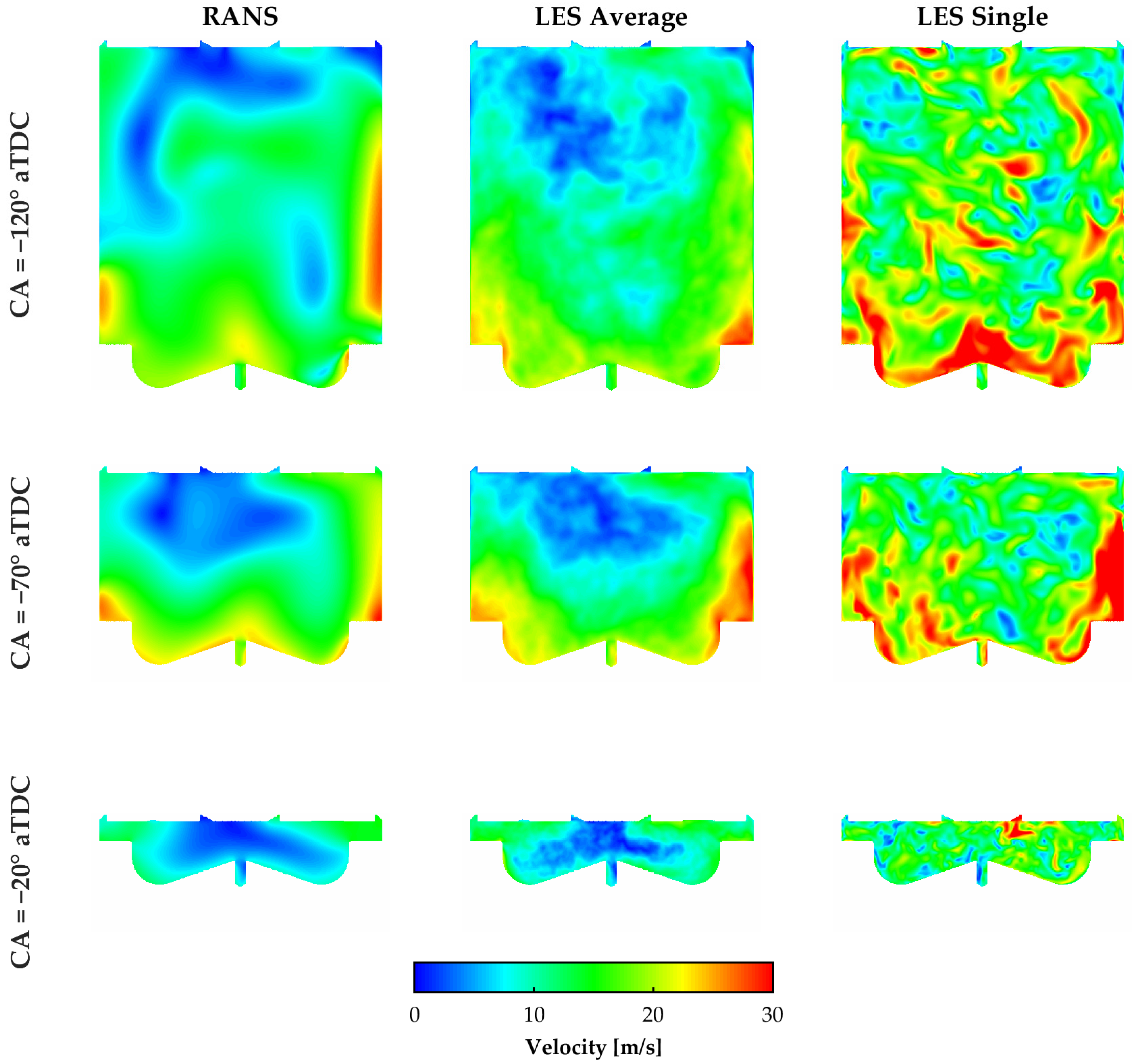
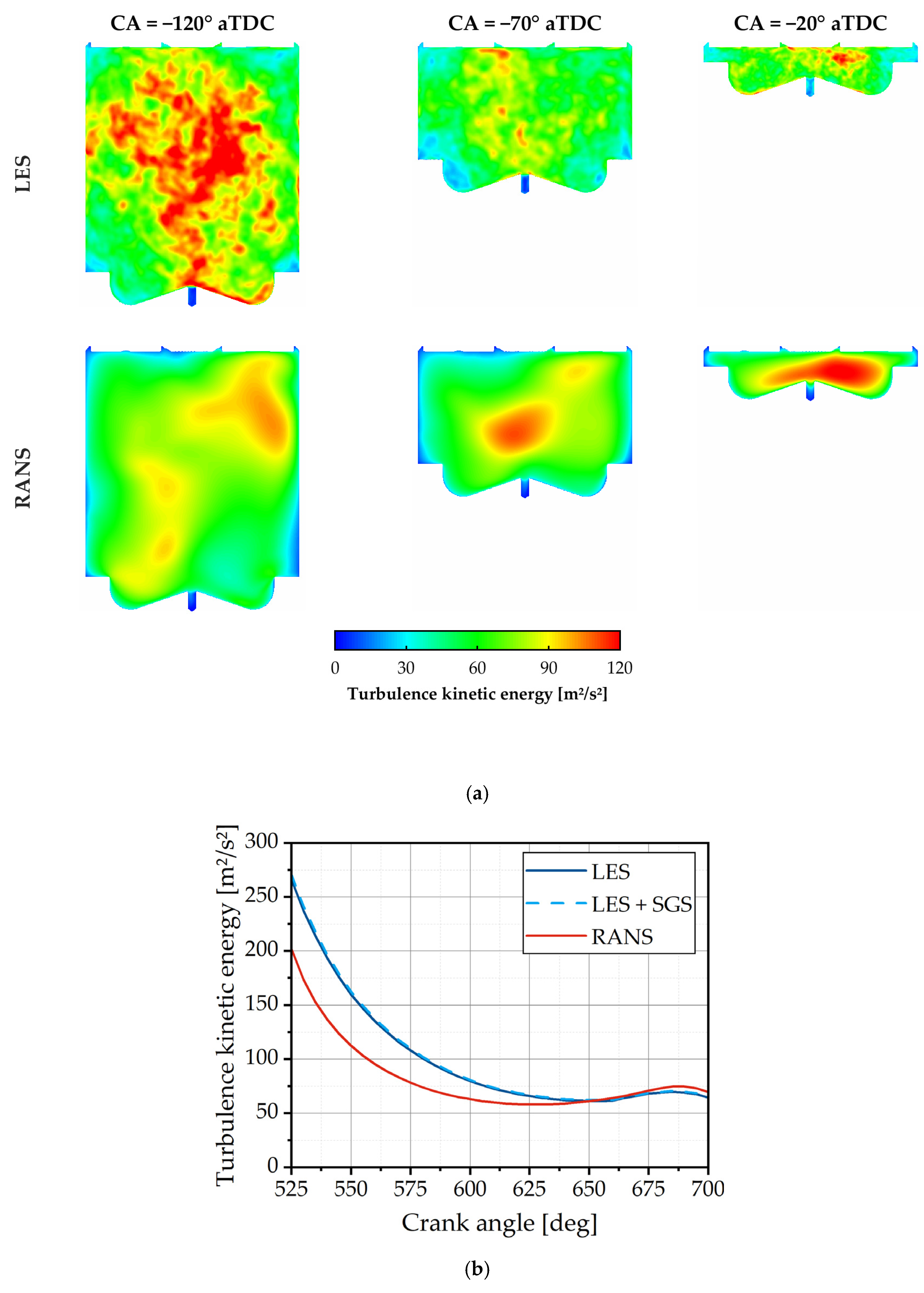
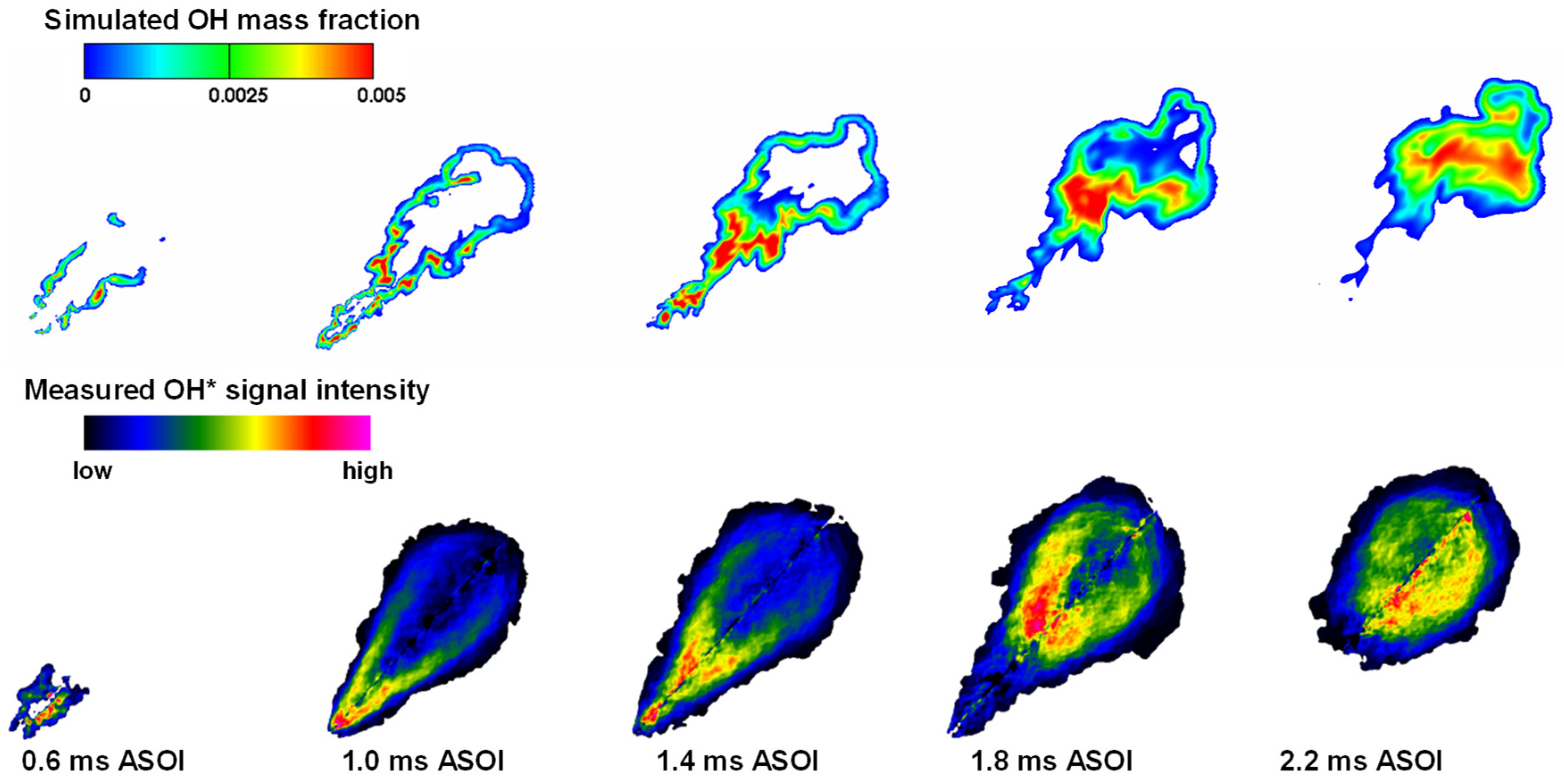
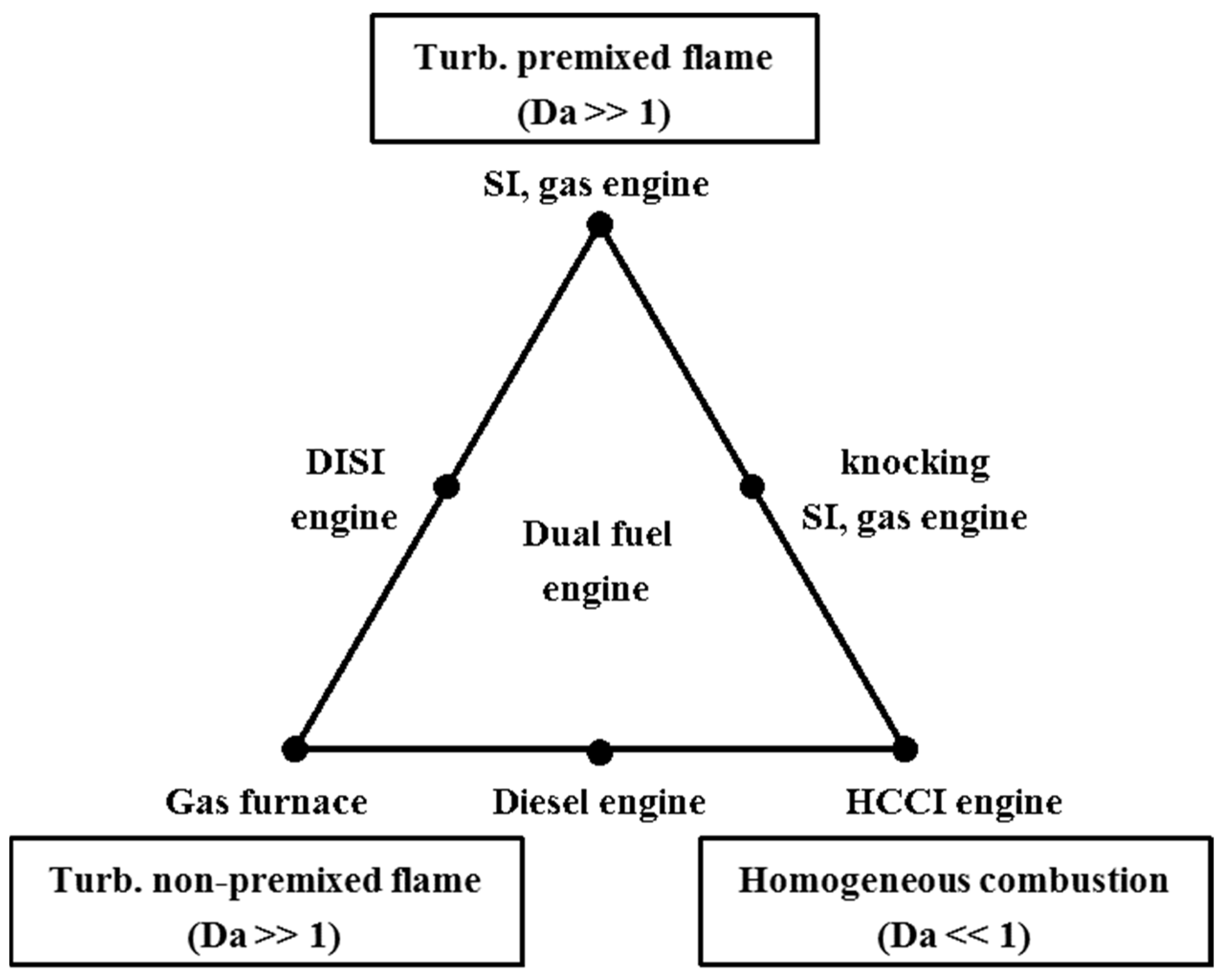
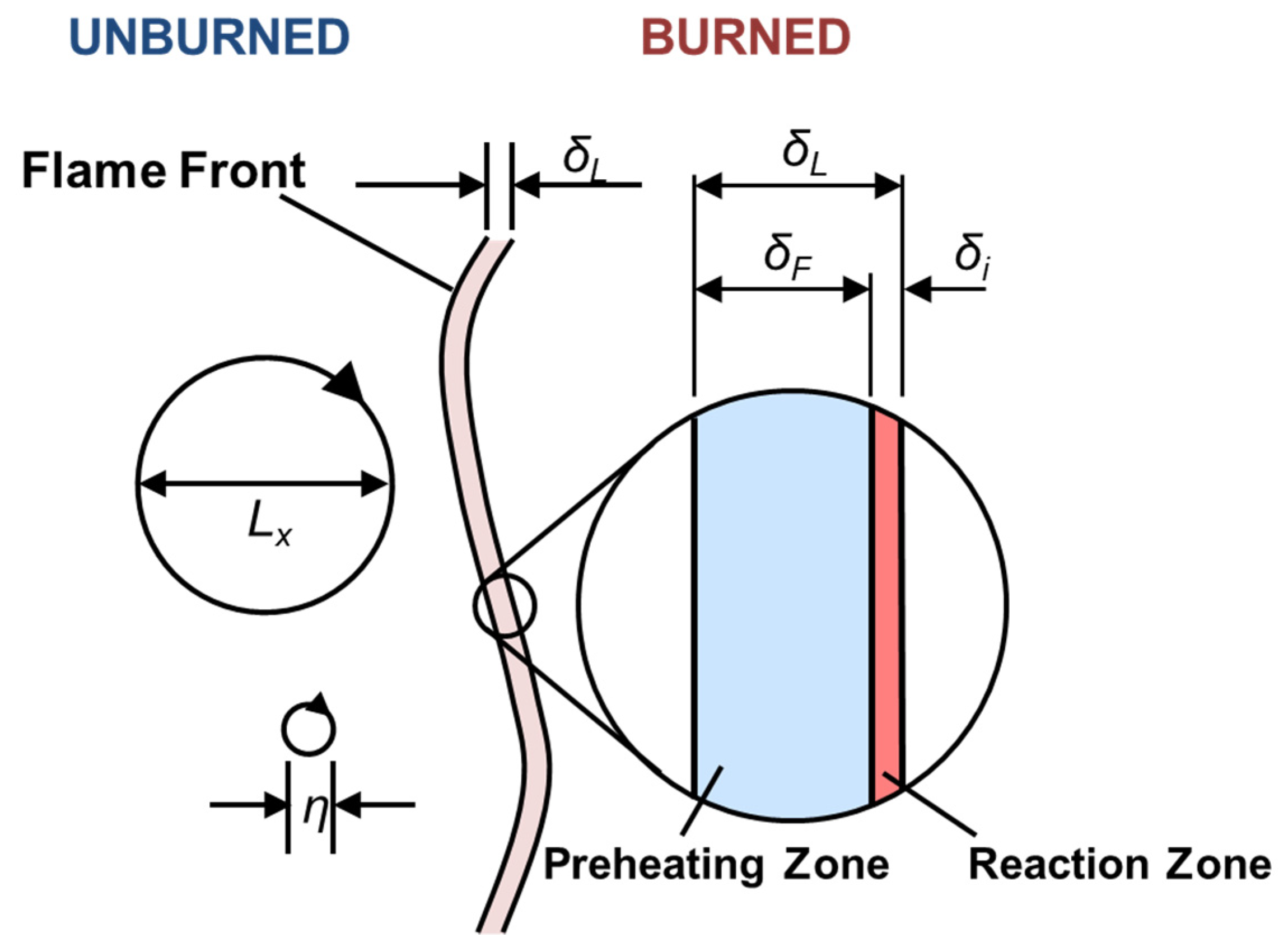


Publisher’s Note: MDPI stays neutral with regard to jurisdictional claims in published maps and institutional affiliations. |
© 2020 by the authors. Licensee MDPI, Basel, Switzerland. This article is an open access article distributed under the terms and conditions of the Creative Commons Attribution (CC BY) license (http://creativecommons.org/licenses/by/4.0/).
Share and Cite
Lauer, T.; Frühhaber, J. Towards a Predictive Simulation of Turbulent Combustion?—An Assessment for Large Internal Combustion Engines. Energies 2021, 14, 43. https://doi.org/10.3390/en14010043
Lauer T, Frühhaber J. Towards a Predictive Simulation of Turbulent Combustion?—An Assessment for Large Internal Combustion Engines. Energies. 2021; 14(1):43. https://doi.org/10.3390/en14010043
Chicago/Turabian StyleLauer, Thomas, and Jens Frühhaber. 2021. "Towards a Predictive Simulation of Turbulent Combustion?—An Assessment for Large Internal Combustion Engines" Energies 14, no. 1: 43. https://doi.org/10.3390/en14010043





